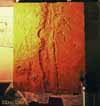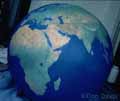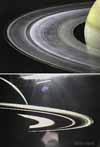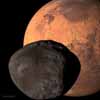 Black and white Mars globe painted
in oils using Mariners 4, 6, and 7 photography. Used to assist
in providing context for Mariner 9 mapping photography.
Black and white Mars globe painted
in oils using Mariners 4, 6, and 7 photography. Used to assist
in providing context for Mariner 9 mapping photography.
PHYSICAL MODELS
U.S.G.S.
 Black and white Mars globe painted
in oils using Mariners 4, 6, and 7 photography. Used to assist
in providing context for Mariner 9 mapping photography.
Black and white Mars globe painted
in oils using Mariners 4, 6, and 7 photography. Used to assist
in providing context for Mariner 9 mapping photography.
'COSMOS'
 'Scratch built' model of Venera 9 lander
used atop a 'table top' landscape model.
'Scratch built' model of Venera 9 lander
used atop a 'table top' landscape model.
Painted 16
inch Mars globe. Later used in 'Star trek-The next generation'
episode 'The Best Of Both Worlds'
 'Table top' model of the Ius Chasma
section of the Vallis Marineris
'Table top' model of the Ius Chasma
section of the Vallis Marineris
![]() Vallis
Marinaris section for 'fly through' sequence. 24 foot plaster,
stiffened cloth, cardboard and plywood.
Vallis
Marinaris section for 'fly through' sequence. 24 foot plaster,
stiffened cloth, cardboard and plywood.
![]() Surface
model of Titan using optimistic assumptions on percentage of cloud
cover. This was my first table top model, with wax embellishments
made by a Cosmos artist Brown. The background was jointly painted
by Adolf Schaller and I.
Surface
model of Titan using optimistic assumptions on percentage of cloud
cover. This was my first table top model, with wax embellishments
made by a Cosmos artist Brown. The background was jointly painted
by Adolf Schaller and I.
 Three foot diameter Earth globe at
first for space simulation shots. Adolf Schaller painted an identical
sized black and white cloud pattern globe for photographic superimposing
on mine. Spheres were fabricated for us, we coated them with gesso
and I gridded the sphere, then drew in a very detailed coastline
with a rapidograph pen. I painted most of the land, several helped
on the water. It was like painting a very detailed map on a 4
by 8 foot gessoed Masonite panel. Only one shot used the globe/cloud
combination, but the globe was used to trace the paths of great
explorations in an episode.
Three foot diameter Earth globe at
first for space simulation shots. Adolf Schaller painted an identical
sized black and white cloud pattern globe for photographic superimposing
on mine. Spheres were fabricated for us, we coated them with gesso
and I gridded the sphere, then drew in a very detailed coastline
with a rapidograph pen. I painted most of the land, several helped
on the water. It was like painting a very detailed map on a 4
by 8 foot gessoed Masonite panel. Only one shot used the globe/cloud
combination, but the globe was used to trace the paths of great
explorations in an episode.
PBS shows 'planet Earth', 'Infinite Voyage', and 'Space Age'.
 This 30 inch Earth globe was sculpted
with land and ocean floor details. I did about 60 percent of the
modeling for the master mold from which this production globe
was made.
This 30 inch Earth globe was sculpted
with land and ocean floor details. I did about 60 percent of the
modeling for the master mold from which this production globe
was made.
 Dr. Ed Stone, then soon-to-be head
of JPL, inspects the Voyager model we borrowed and embellished
to look like the full scale mockup in Von Karmen Auditorium for
the PBS show 'Infinite Voyage' episode 'Sail On, Voyager. I supervised
the detailing work on the model.
Dr. Ed Stone, then soon-to-be head
of JPL, inspects the Voyager model we borrowed and embellished
to look like the full scale mockup in Von Karmen Auditorium for
the PBS show 'Infinite Voyage' episode 'Sail On, Voyager. I supervised
the detailing work on the model.
 The rings of Saturn, painted on two
sides of plexiglass so as to simulate the appearance of the rings
under varied lighting conditions. After all that work they only
looked good from the intended angle they were to be filmed from,
which of course was all we needed.
The rings of Saturn, painted on two
sides of plexiglass so as to simulate the appearance of the rings
under varied lighting conditions. After all that work they only
looked good from the intended angle they were to be filmed from,
which of course was all we needed.
 Table top model of Triton, Neptune's
large moon. The geyser was fashioned from cotton, the rest of
the model from painted plaster.
Table top model of Triton, Neptune's
large moon. The geyser was fashioned from cotton, the rest of
the model from painted plaster.
 A 4 foot diameter hemisphere of Mars,
with relief sculpted in colored gesso.
A 4 foot diameter hemisphere of Mars,
with relief sculpted in colored gesso.
 Table top Lunar Landscape model for
Lunar base sequence of Moon episode of 'Space Age'. Hundreds of
pounds of plaster and many containers of pigments were used. Dried
plaster was pounded and sorted into various containers. Foreground
textures used the coarser pieces, finer grades were used with
distance until the furthest features, themselves modeled in compressed
'forced perspective' were almost powdery. A brilliant 'sun lamp'
lit the approximately 10 by 20 foot model.
Table top Lunar Landscape model for
Lunar base sequence of Moon episode of 'Space Age'. Hundreds of
pounds of plaster and many containers of pigments were used. Dried
plaster was pounded and sorted into various containers. Foreground
textures used the coarser pieces, finer grades were used with
distance until the furthest features, themselves modeled in compressed
'forced perspective' were almost powdery. A brilliant 'sun lamp'
lit the approximately 10 by 20 foot model.
DIGITAL MODELS
![]() Mars Pathfinder lander, Rover, and
the immediate surroundings rendered in Electric Image software
as a panorama.
Mars Pathfinder lander, Rover, and
the immediate surroundings rendered in Electric Image software
as a panorama.
 Phobos shape model. derived from combining
existing digital models with more detailed photographic maps.
Phobos shape model. derived from combining
existing digital models with more detailed photographic maps.
![]() Shape model created in Cybermesh using Galileo's highest
resolution photograph of Callisto as reference, then that photo
was projected as a texture map atop the model. Portrayal suffers
from oblique angle of the original photography.
Shape model created in Cybermesh using Galileo's highest
resolution photograph of Callisto as reference, then that photo
was projected as a texture map atop the model. Portrayal suffers
from oblique angle of the original photography.